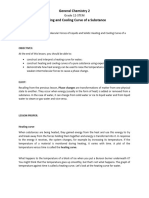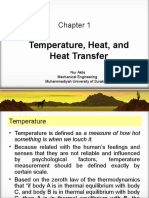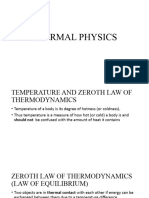0 ratings0% found this document useful (0 votes)
36 viewsLecture 20
Calorimetry is a technique used to measure specific heat by heating a material and adding it to water, recording the final temperature. A calorimeter isolates the sample and water system, and conservation of energy dictates that energy leaving the sample equals energy entering the water. The temperature change can be used to calculate the specific heat of the sample. Phase changes also involve energy transfers without temperature change that can be calculated using latent heat values.
Uploaded by
ShootingStarPhotonsCopyright
© © All Rights Reserved
Available Formats
Download as PDF, TXT or read online on Scribd
0 ratings0% found this document useful (0 votes)
36 viewsLecture 20
Calorimetry is a technique used to measure specific heat by heating a material and adding it to water, recording the final temperature. A calorimeter isolates the sample and water system, and conservation of energy dictates that energy leaving the sample equals energy entering the water. The temperature change can be used to calculate the specific heat of the sample. Phase changes also involve energy transfers without temperature change that can be calculated using latent heat values.
Uploaded by
ShootingStarPhotonsCopyright
© © All Rights Reserved
Available Formats
Download as PDF, TXT or read online on Scribd
You are on page 1/ 28
Calorimetry
One technique for measuring specific heat
involves heating a material, adding it to a
sample of water, and recording the final
temperature
This technique is known as calorimetry
A calorimeter is a device in which this energy
transfer takes place
Calorimetry
The system of the sample and the water is
isolated
Conservation of energy requires that the
amount of energy that leaves the sample
equals the amount of energy that enters
the water
Conservation of Energy gives a
mathematical expression of this:
Q
cold
= -Q
hot
Calorimetry
The negative sign in the equation is critical for
consistency with the established sign convention
Since each Q = mcT, c
sample
can be found by:
NOTE: the mass and c of the container should be
included, but if m
w
>>m
container
it can be neglected
Calorimetry, Example
An ingot of metal is heated and then
dropped into a beaker of water. The
equilibrium temperature is measured
A calorimeter is a device that helps scientists measure the energy of a particle.
This triangular section is layered with sheets of lead and plastic. The lead is heavy
and dense, so the particles have a hard time going through it. Scientists can tell how
much energy a particle had by seeing how much lead it took to stop it.
CALORIMETRY for high energy physics
Phase Changes
A phase change is when a substance
changes from one form to another
Two common phase changes are
Solid to liquid (melting)
Liquid to gas (boiling)
During a phase change, there is no
change in temperature of the substance
Equilibrium can exist not only between the liquid and vapor phase
of a substance but also between the solid and liquid phases, and
the solid and gas phases of a substance.
A phase diagram is a graphical way to depict the effects of pressure
and temperature on the phase of a substance:
Phase Diagrams (P,T)
Latent Heat
Different substances react differently to the
energy added or removed during a phase
change
Due to their different molecular arrangements
The amount of energy also depends on the
mass of the sample
If an amount of energy Q is required to change
the phase of a sample of mass m
L = Q /m or Q = mL
Latent Heat
The quantity L is called the latent heat of
the material
Latent means hidden
The value of L depends on the substance as
well as the actual phase change
The energy required to change the phase
is Q = mL
Latent Heat
The latent heat of fusion is used when the phase
change is from solid to liquid
The latent heat of vaporization is used when the
phase change is from liquid to gas
The positive sign is used when the energy is
transferred into the system
This will result in melting or boiling
The negative sign is used when energy is
transferred out of the system
This will result in freezing or condensation
Equilibrium can exist not only between the liquid and vapor phase
of a substance but also between the solid and liquid phases, and
the solid and gas phases of a substance.
A phase diagram is a graphical way to depict the effects of pressure
and temperature on the phase of a substance:
Phase Diagrams (P,T)
Sample Latent Heat Values
SOLIDS
The particles vibrate around fixed
positions.
They are close together and so
attract each other strongly. This is
why solids maintain their shape.
LIQUIDS
The particles are still relatively close
together but now have enough
energy to "change places" with
each other. This is why liquids can
flow.
GASES
Average distance between particles
typically 10 times greater than in
solids and liquids. The particles now
move freely at random, occupying
all the space available to them.
Graph of Ice to Steam
Note:all heat values are for 1 gram of water
Warming Ice, Graph Part A
Start with one gram of
ice at 30.0C
During phase A, the
temperature of the ice
changes from 30.0C
to 0C
Use Q = m
i
c
i
?T
In this case, 62.7 J of
energy are added
Melting Ice, Graph Part B
Once at 0C, the
phase change
(melting) starts
The temperature stays
the same although
energy is still being
added
Use Q = m
i
L
f
The energy required is 333 J
On the graph, the values move
from 62.7 J to 396 J
Warming Water, Graph Part C
Between 0C and 100C, the
material is liquid and no
phase changes take place
Energy added increases the
temperature
Use Q = m
w
c
w
?T
419 J are added
The total is now 815 J
Boiling Water, Graph Part D
At 100C, a phase
change occurs
(boiling)
Temperature does not
change
Use Q = m
w
L
v
This requires 2260 J
The total is now 3070 J
Heating Steam
After all the water is converted
to steam, the steam will heat
up
No phase change occurs
The added energy goes to
increasing the temperature
Use Q = m
s
c
s
?T
In this case, 40.2 J are needed
The temperature is going to 120
o
C
The total is now 3110 J
SOLIDS
The particles vibrate around fixed
positions.
They are close together and so
attract each other strongly. This is
why solids maintain their shape.
LIQUIDS
The particles are still relatively close
together but now have enough
energy to "change places" with
each other. This is why liquids can
flow.
GASES
Average distance between particles
typically 10 times greater than in
solids and liquids. The particles now
move freely at random, occupying
all the space available to them.
Molecular View of Phase Changes
Phase changes can be described in terms of the
rearrangement of molecules (or atoms in an elemental
substance)
Liquid to Gas phase change
Molecules in a liquid are close together
The forces between them are stronger than those in a gas
Work must be done to separate the molecules
The latent heat of vaporization is the energy per unit mass
needed to accomplish this separation
Molecular View of Phase Changes
Solid to Liquid phase change
The addition of energy will cause the amplitude of the
vibration of the molecules about their equilibrium position
to increase
At the melting point, the amplitude is great enough to
break apart bonds between the molecules
The molecules can move to new positions
The molecules in the liquid are bound together less
strongly than those of the solid
They have less nearest neighbours
The latent heat of fusion is the energy per unit mass
required to go from the solid-type to the liquid-type bonds
Molecular View of Phase Changes
The latent heat of vaporization is greater
than the latent heat of fusion
In the liquid-to-gas phase change, all bonds
are broken
The gas molecules are essentially not bonded
to each other
It takes more energy to completely break
the bonds than to change the type of
bonds
Close-Packed Structures are the most efficient way to fill space with spheres
Features of Close-Packing:
Coordination Number = 12
74% of space is occupied
There is the Avogadro number N
A
of atoms in the mole of a solid.
We assume that each atom has n nearest neighbours and the strength of
the pair-wise interaction between atoms is equal to .
Then the energy required to melt one mole (latent heat of melting) is
approximately equal:
L N
A
?n,
where ?n is the change of the number of nearest neighbours from
solid to liquid or vapour and stands to avoid the double counting.
We can then use n = 12 for a solid and n 10 for a melt. Then
L
melt
N
A
n, where n = 2,
change of the coordination number from crystal to vapour n = 12
Estimating melting and sublimation energies
Calorimetry Problem-Solving Strategy
Units of measure must be consistent
For example, if your value of c is in J/kg
.o
C,
then your mass must be in kg, the
temperatures in
o
C and energies in J
Transfers of energy are given by
Q =mc T only when no phase change
occurs
If there is a phase change, use Q = mL
Calorimetry Problem-Solving Strategy
Be sure to select the correct sign for all
energy transfers
Remember to use Q
cold
= - Q
hot
The T is always T
f
- T
i
You might also like
- Detailed Notes - Section 03 Waves - AQA Physics A-Level PDFNo ratings yetDetailed Notes - Section 03 Waves - AQA Physics A-Level PDF12 pages
- Gen Chem 2 - Lesson 4. Phase Changes and Phase DiagramNo ratings yetGen Chem 2 - Lesson 4. Phase Changes and Phase Diagram39 pages
- Intermolecular Forces of Liquids and Solids Phase ChangesNo ratings yetIntermolecular Forces of Liquids and Solids Phase Changes83 pages
- Detailed Notes - Section 06 Thermal Physics - AQA Physics A-LevelNo ratings yetDetailed Notes - Section 06 Thermal Physics - AQA Physics A-Level9 pages
- Intermolecular Forces of Liquids and Solids Phase ChangesNo ratings yetIntermolecular Forces of Liquids and Solids Phase Changes27 pages
- Heating and Cooling Curve of A Substance 1No ratings yetHeating and Cooling Curve of A Substance 15 pages
- Chapter Eleven: Energy in Thermal ProcessesNo ratings yetChapter Eleven: Energy in Thermal Processes50 pages
- Temperature, Heat, and Heat Transfer: Nur Aklis Mechanical Engineering Muhammadiyah University of SurakartaNo ratings yetTemperature, Heat, and Heat Transfer: Nur Aklis Mechanical Engineering Muhammadiyah University of Surakarta26 pages
- IB CHAPTER 3 - Thermal Properties of MatterNo ratings yetIB CHAPTER 3 - Thermal Properties of Matter15 pages
- Properties of Pure Substances: Chapter TwoNo ratings yetProperties of Pure Substances: Chapter Two52 pages
- Medical Physics, Lecture-5.Ppt (Compatibility Mode)No ratings yetMedical Physics, Lecture-5.Ppt (Compatibility Mode)30 pages
- 7 Thermal Expansion of Solids and Liquids Dr. AborisadeNo ratings yet7 Thermal Expansion of Solids and Liquids Dr. Aborisade63 pages
- Molar Specific Heats of Other MaterialsNo ratings yetMolar Specific Heats of Other Materials25 pages
- تقرير عن التجربة الاولى في الثرموداينمك 1No ratings yetتقرير عن التجربة الاولى في الثرموداينمك 17 pages
- Chapter Ten Thermodynamics: Temperature and The Zeroth Law of ThermodynamicsNo ratings yetChapter Ten Thermodynamics: Temperature and The Zeroth Law of Thermodynamics7 pages
- Practice Makes Perfect in Chemistry: The Physical Behavior of Matter with AnswersFrom EverandPractice Makes Perfect in Chemistry: The Physical Behavior of Matter with AnswersNo ratings yet
- Relativistic Astrophysics. 2009. Course Work 5. Solutions: X X 2 X X 2 2No ratings yetRelativistic Astrophysics. 2009. Course Work 5. Solutions: X X 2 X X 2 25 pages
- Relativistic Astrophysics. 2009. Course Work 3. Solutions: Ik IkNo ratings yetRelativistic Astrophysics. 2009. Course Work 3. Solutions: Ik Ik4 pages
- Quantum Mechanics A PHY-319 Problems 3 Issue: Tuesday 24: TH NDNo ratings yetQuantum Mechanics A PHY-319 Problems 3 Issue: Tuesday 24: TH ND2 pages
- Relativistic Astrophysics. 2009. Course Work 3: Ik IkNo ratings yetRelativistic Astrophysics. 2009. Course Work 3: Ik Ik1 page
- Electric and Magnetic Fields Answers To Assignment 3No ratings yetElectric and Magnetic Fields Answers To Assignment 35 pages
- M.Sc. Examination: ASTMO41 Relativistic AstrophysicsNo ratings yetM.Sc. Examination: ASTMO41 Relativistic Astrophysics5 pages
- Electric and Magnetic Fields Answers To Assignment 5 Q1:: 10 For FormulaNo ratings yetElectric and Magnetic Fields Answers To Assignment 5 Q1:: 10 For Formula6 pages
- Electric and Magnetic Fields Answers To Week 2 Assignment Q1 (A)No ratings yetElectric and Magnetic Fields Answers To Week 2 Assignment Q1 (A)4 pages
- Electric and Magnetic Fields Answers To Week 4 AssignmentNo ratings yetElectric and Magnetic Fields Answers To Week 4 Assignment3 pages
- Electric and Magnetic Fields Assignment 7: Questions 1-4 Count For 95% of The Marks and Question 5 For 5% Q1No ratings yetElectric and Magnetic Fields Assignment 7: Questions 1-4 Count For 95% of The Marks and Question 5 For 5% Q12 pages
- Electric and Magnetic Fields Assignment 9: Q1 40 Marks, Q2 25marks, Q3 35 MarksNo ratings yetElectric and Magnetic Fields Assignment 9: Q1 40 Marks, Q2 25marks, Q3 35 Marks2 pages
- Electric and Magnetic Fields: Y X P Charge/unit distance = λNo ratings yetElectric and Magnetic Fields: Y X P Charge/unit distance = λ1 page
- Electric and Magnetic Fields Assignment 8 All Questions Carry Equal MarksNo ratings yetElectric and Magnetic Fields Assignment 8 All Questions Carry Equal Marks2 pages
- System Heat Must Flow From A Hot Region To A ColdNo ratings yetSystem Heat Must Flow From A Hot Region To A Cold25 pages
- Heat Engines and The Second Law of ThermodynamicsNo ratings yetHeat Engines and The Second Law of Thermodynamics24 pages
- Brilliant: Repeaters Neet Model Exam - Unit I, Ii, Iii, Iv, VNo ratings yetBrilliant: Repeaters Neet Model Exam - Unit I, Ii, Iii, Iv, V35 pages
- Units of Measurement To Be Used in Air and Ground OperationsNo ratings yetUnits of Measurement To Be Used in Air and Ground Operations8 pages
- From Wikipedia, The Free Encyclopedia: Centrifugal GovernorNo ratings yetFrom Wikipedia, The Free Encyclopedia: Centrifugal Governor6 pages
- Physics Newton Laws of Motion DCET IIT JEENo ratings yetPhysics Newton Laws of Motion DCET IIT JEE11 pages
- High-Cycle Thermal Fatigue in Mixing Tees. Large-Eddy Simulations Compared To A New Validation ExperimentNo ratings yetHigh-Cycle Thermal Fatigue in Mixing Tees. Large-Eddy Simulations Compared To A New Validation Experiment21 pages
- 2018-Retaining Walls, Indian Highways IRCNo ratings yet2018-Retaining Walls, Indian Highways IRC8 pages
- Indian Institute of Technology Kanpur: ME252 Theory of Mechanisms and Machines AY 2023-24 Semester IINo ratings yetIndian Institute of Technology Kanpur: ME252 Theory of Mechanisms and Machines AY 2023-24 Semester II3 pages
- 1616403830254-Subjective Questions On Strength of Material MET - 06No ratings yet1616403830254-Subjective Questions On Strength of Material MET - 065 pages
- Computers and Geotechnics: A. Tolooiyan, K. GavinNo ratings yetComputers and Geotechnics: A. Tolooiyan, K. Gavin9 pages
- NCERT Solutions For Class 11 Physics Chapter 6 - Work Energy and Power - .No ratings yetNCERT Solutions For Class 11 Physics Chapter 6 - Work Energy and Power - .23 pages
- AP Physics 1: Algebra-Based: Sample Student Responses and Scoring CommentaryNo ratings yetAP Physics 1: Algebra-Based: Sample Student Responses and Scoring Commentary13 pages
- Detailed Notes - Section 03 Waves - AQA Physics A-Level PDFDetailed Notes - Section 03 Waves - AQA Physics A-Level PDF
- Gen Chem 2 - Lesson 4. Phase Changes and Phase DiagramGen Chem 2 - Lesson 4. Phase Changes and Phase Diagram
- Intermolecular Forces of Liquids and Solids Phase ChangesIntermolecular Forces of Liquids and Solids Phase Changes
- Detailed Notes - Section 06 Thermal Physics - AQA Physics A-LevelDetailed Notes - Section 06 Thermal Physics - AQA Physics A-Level
- Intermolecular Forces of Liquids and Solids Phase ChangesIntermolecular Forces of Liquids and Solids Phase Changes
- Temperature, Heat, and Heat Transfer: Nur Aklis Mechanical Engineering Muhammadiyah University of SurakartaTemperature, Heat, and Heat Transfer: Nur Aklis Mechanical Engineering Muhammadiyah University of Surakarta
- Medical Physics, Lecture-5.Ppt (Compatibility Mode)Medical Physics, Lecture-5.Ppt (Compatibility Mode)
- 7 Thermal Expansion of Solids and Liquids Dr. Aborisade7 Thermal Expansion of Solids and Liquids Dr. Aborisade
- Chapter Ten Thermodynamics: Temperature and The Zeroth Law of ThermodynamicsChapter Ten Thermodynamics: Temperature and The Zeroth Law of Thermodynamics
- Practice Makes Perfect in Chemistry: The Physical Behavior of MatterFrom EverandPractice Makes Perfect in Chemistry: The Physical Behavior of Matter
- Practice Makes Perfect in Chemistry: The Physical Behavior of Matter with AnswersFrom EverandPractice Makes Perfect in Chemistry: The Physical Behavior of Matter with Answers
- Relativistic Astrophysics. 2009. Course Work 5. Solutions: X X 2 X X 2 2Relativistic Astrophysics. 2009. Course Work 5. Solutions: X X 2 X X 2 2
- Relativistic Astrophysics. 2009. Course Work 3. Solutions: Ik IkRelativistic Astrophysics. 2009. Course Work 3. Solutions: Ik Ik
- Quantum Mechanics A PHY-319 Problems 3 Issue: Tuesday 24: TH NDQuantum Mechanics A PHY-319 Problems 3 Issue: Tuesday 24: TH ND
- Relativistic Astrophysics. 2009. Course Work 3: Ik IkRelativistic Astrophysics. 2009. Course Work 3: Ik Ik
- Electric and Magnetic Fields Answers To Assignment 3Electric and Magnetic Fields Answers To Assignment 3
- M.Sc. Examination: ASTMO41 Relativistic AstrophysicsM.Sc. Examination: ASTMO41 Relativistic Astrophysics
- Electric and Magnetic Fields Answers To Assignment 5 Q1:: 10 For FormulaElectric and Magnetic Fields Answers To Assignment 5 Q1:: 10 For Formula
- Electric and Magnetic Fields Answers To Week 2 Assignment Q1 (A)Electric and Magnetic Fields Answers To Week 2 Assignment Q1 (A)
- Electric and Magnetic Fields Answers To Week 4 AssignmentElectric and Magnetic Fields Answers To Week 4 Assignment
- Electric and Magnetic Fields Assignment 7: Questions 1-4 Count For 95% of The Marks and Question 5 For 5% Q1Electric and Magnetic Fields Assignment 7: Questions 1-4 Count For 95% of The Marks and Question 5 For 5% Q1
- Electric and Magnetic Fields Assignment 9: Q1 40 Marks, Q2 25marks, Q3 35 MarksElectric and Magnetic Fields Assignment 9: Q1 40 Marks, Q2 25marks, Q3 35 Marks
- Electric and Magnetic Fields: Y X P Charge/unit distance = λElectric and Magnetic Fields: Y X P Charge/unit distance = λ
- Electric and Magnetic Fields Assignment 8 All Questions Carry Equal MarksElectric and Magnetic Fields Assignment 8 All Questions Carry Equal Marks
- Brilliant: Repeaters Neet Model Exam - Unit I, Ii, Iii, Iv, VBrilliant: Repeaters Neet Model Exam - Unit I, Ii, Iii, Iv, V
- Units of Measurement To Be Used in Air and Ground OperationsUnits of Measurement To Be Used in Air and Ground Operations
- From Wikipedia, The Free Encyclopedia: Centrifugal GovernorFrom Wikipedia, The Free Encyclopedia: Centrifugal Governor
- High-Cycle Thermal Fatigue in Mixing Tees. Large-Eddy Simulations Compared To A New Validation ExperimentHigh-Cycle Thermal Fatigue in Mixing Tees. Large-Eddy Simulations Compared To A New Validation Experiment
- Indian Institute of Technology Kanpur: ME252 Theory of Mechanisms and Machines AY 2023-24 Semester IIIndian Institute of Technology Kanpur: ME252 Theory of Mechanisms and Machines AY 2023-24 Semester II
- 1616403830254-Subjective Questions On Strength of Material MET - 061616403830254-Subjective Questions On Strength of Material MET - 06
- NCERT Solutions For Class 11 Physics Chapter 6 - Work Energy and Power - .NCERT Solutions For Class 11 Physics Chapter 6 - Work Energy and Power - .
- AP Physics 1: Algebra-Based: Sample Student Responses and Scoring CommentaryAP Physics 1: Algebra-Based: Sample Student Responses and Scoring Commentary























































































































